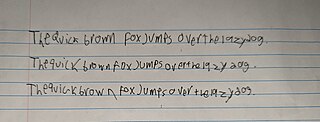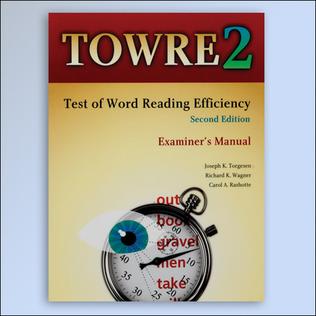Related Research Articles

Dyslexia, previously known as word blindness, is a learning disability that affects either reading or writing. Different people are affected to different degrees. Problems may include difficulties in spelling words, reading quickly, writing words, "sounding out" words in the head, pronouncing words when reading aloud and understanding what one reads. Often these difficulties are first noticed at school. The difficulties are involuntary, and people with this disorder have a normal desire to learn. People with dyslexia have higher rates of attention deficit hyperactivity disorder (ADHD), developmental language disorders, and difficulties with numbers.
Dyscalculia is a disability resulting in difficulty learning or comprehending arithmetic, such as difficulty in understanding numbers, learning how to manipulate numbers, performing mathematical calculations, and learning facts in mathematics. It is sometimes colloquially referred to as "math dyslexia", though this analogy is misleading as they are distinct syndromes.

Dysgraphia is a neurological disorder and learning disability that concerns impairments in written expression, which affects the ability to write, primarily handwriting, but also coherence. It is a specific learning disability (SLD) as well as a transcription disability, meaning that it is a writing disorder associated with impaired handwriting, orthographic coding and finger sequencing. It often overlaps with other learning disabilities and neurodevelopmental disorders such as speech impairment, attention deficit hyperactivity disorder (ADHD) or developmental coordination disorder (DCD).
Reading for special needs has become an area of interest as the understanding of reading has improved. Teaching children with special needs how to read was not historically pursued due to perspectives of a Reading Readiness model. This model assumes that a reader must learn to read in a hierarchical manner such that one skill must be mastered before learning the next skill. This approach often led to teaching sub-skills of reading in a decontextualized manner. This style of teaching made it difficult for children to master these early skills, and as a result, did not advance to more advanced literacy instruction and often continued to receive age-inappropriate instruction.
Phonological awareness is an individual's awareness of the phonological structure, or sound structure, of words. Phonological awareness is an important and reliable predictor of later reading ability and has, therefore, been the focus of much research.
A reading disability is a condition in which a person displays difficulty reading. Examples of reading disabilities include: developmental dyslexia, And alexia,

Learning disability, learning disorder, or learning difficulty is a condition in the brain that causes difficulties comprehending or processing information and can be caused by several different factors. Given the "difficulty learning in a typical manner", this does not exclude the ability to learn in a different manner. Therefore, some people can be more accurately described as having a "learning difference", thus avoiding any misconception of being disabled with a possible lack of an ability to learn and possible negative stereotyping. In the United Kingdom, the term "learning disability" generally refers to an intellectual disability, while conditions such as dyslexia and dyspraxia are usually referred to as "learning difficulties".
The phonological deficit hypothesis is a prevalent cognitive-level explanation for the cause of reading difficulties and dyslexia. It stems from evidence that individuals with dyslexia tend to do poorly on tests which measure their ability to decode nonsense words using conventional phonetic rules, and that there is a high correlation between difficulties in connecting the sounds of language to letters and reading delays or failure in children.
Auditory processing disorder (APD), rarely known as King-Kopetzky syndrome or auditory disability with normal hearing (ADN), is a neurodevelopmental disorder affecting the way the brain processes sounds. Individuals with APD usually have normal structure and function of the ear, but cannot process the information they hear in the same way as others do, which leads to difficulties in recognizing and interpreting sounds, especially the sounds composing speech. It is thought that these difficulties arise from dysfunction in the central nervous system. This is, in part, essentially a failure of the cocktail party effect found in most people.

Management of dyslexia depends on a multitude of variables; there is no one specific strategy or set of strategies that will work for all who have dyslexia.
Language-based learning disabilities or LBLD are "heterogeneous" neurological differences that can affect skills such as listening, reasoning, speaking, reading, writing, and math calculations. It is also associated with movement, coordination, and direct attention. LBLD is not usually identified until the child reaches school age. Most people with this disability find it hard to communicate, to express ideas efficiently and what they say may be ambiguous and hard to understand It is a neurological difference. It is often hereditary, and is frequently associated to specific language problems.
The history of dyslexia research spans from the late 1800s to the present.
Dyslexia is a reading disorder wherein an individual experiences trouble with reading. Individuals with dyslexia have normal levels of intelligence but can exhibit difficulties with spelling, reading fluency, pronunciation, "sounding out" words, writing out words, and reading comprehension. The neurological nature and underlying causes of dyslexia are an active area of research. However, some experts believe that the distinction of dyslexia as a separate reading disorder and therefore recognized disability is a topic of some controversy.
Dyslexia is a complex, lifelong disorder involving difficulty in learning to read or interpret words, letters and other symbols. Dyslexia does not affect general intelligence, but is often co-diagnosed with ADHD. There are at least three sub-types of dyslexia that have been recognized by researchers: orthographic, or surface dyslexia, phonological dyslexia and mixed dyslexia where individuals exhibit symptoms of both orthographic and phonological dyslexia. Studies have shown that dyslexia is genetic and can be passed down through families, but it is important to note that, although a genetic disorder, there is no specific locus in the brain for reading and writing. The human brain does have language centers, but written language is a cultural artifact, and a very complex one requiring brain regions designed to recognize and interpret written symbols as representations of language in rapid synchronization. The complexity of the system and the lack of genetic predisposition for it is one possible explanation for the difficulty in acquiring and understanding written language.

Dyslexia is a disorder characterized by problems with the visual notation of speech, which in most languages of European origin are problems with alphabet writing systems which have a phonetic construction. Examples of these issues can be problems speaking in full sentences, problems correctly articulating Rs and Ls as well as Ms and Ns, mixing up sounds in multi-syllabic words, problems of immature speech such as "wed and gween" instead of "red and green".
Rapid automatized naming (RAN) is a task that measures how quickly individuals can name aloud objects, pictures, colors, or symbols. Variations in rapid automatized naming time in children provide a strong predictor of their later ability to read, and is independent from other predictors such as phonological awareness, verbal IQ, and existing reading skills. Importantly, rapid automatized naming of pictures and letters can predict later reading abilities for pre-literate children.
David P. Hurford is a psychologist and researcher who specializes in dyslexia/reading difficulties and attention deficit hyperactivity disorder (ADHD). He is a professor and chair of the Department of Psychology and Counseling at Pittsburg State University and directs the Center for Research, Evaluation and Awareness of Dyslexia at the same institution. In addition, he is the president of Reading Screening, LLC and the manager of the Center for the Assessment and Remediation of Reading Difficulties, Inc. a nonprofit created to help individuals become competent readers and was a Spencer Fellow of the National Academy of Education.
Dr Hollis Scarborough is an American psychologist and literacy expert who is a senior scientist at Haskins Laboratories in New Haven, Connecticut. She has been a leading researcher in the area of reading acquisition since 1981, and has been involved with efforts to improve US national policy on the teaching of reading.
Dynaread Special Education Corporation is a provider of dyslexia remediation services specifically designed for older struggling readers.

Test of Word Reading Efficiency Second Edition or commonly known as TOWRE - 2 is a kind of reading test developed to test the efficiency of reading ability of children from age 6–24 years. It generally seeks to measure an individual's accuracy and fluency regarding two efficiencies; Sight Word Efficiency (SWE) and Phonemic Decoding Efficiency (PDE). SWE measures ability of pronouncing words that are printed and PDE assesses the quantity of pronouncing phonemically regular non-words. TOWRE - 2 is a very simple test which can be administered by teachers and aides, and it only takes five minutes to complete the procedure. It is commonly used in reading research, classroom assessment and clinical practice. This test is both straightforward and easy to use because it does not require a lot of materials and can be administered by teachers and aides.
References
- 1 2 3 4 5 6 "Center for Research, Evaluation and Awareness of Dyslexia (2022)". www.schoolandcollegelistings.com. Retrieved 2022-03-24.
- 1 2 "Research & Resources | CARRD, Inc". www.carrdinc.org. Retrieved 2022-04-05.
- 1 2 "Reading Comprehension Assessment Strategies & Reading Level Testing - ReadingScreening.Org". 2013-05-12. Archived from the original on 2013-05-12. Retrieved 2022-04-05.
- ↑ "Understanding Dyslexia". Child Mind Institute. Retrieved 2022-04-05.
- ↑ Germanò, Eva; Gagliano, Antonella; Curatolo, Paolo (18 August 2010). "Comorbidity of ADHD and Dyslexia". Developmental Neuropsychology. 35 (5): 475–493. doi:10.1080/87565641.2010.494748. PMID 20721770. S2CID 42046958.
